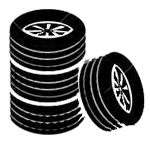What is a 'traction circle'?
Also know as the circle of forces, the 'traction circle' is not a real thing. It is a concept - a model for describing tire grip on a car.
The basic principle is simple: tires can only grip so much, in any direction, before they lose grip and start to slide. The sliding is caused by force on the tire. The forces are caused by acceleration, braking, cornering, or some combination of these.
Using a bit of simple physics, the tire grip can be represented by a circle surrounding the contact patch of the tire. The bigger the circle, the more traction the tire has - hence, the term 'traction circle'. If tires gripped equally well in all directions, the 'traction circle' really would be a circle. Since most tires don't, the traction circle is usually oval shaped.
Although it is difficult to actually model a traction circle for any given tire, the concept is helpful to performance drivers because it perfectly describes the relationship between braking and cornering grip on a tire. If the driver stays within the traction circle of the tire, the tire sticks. Stay on the edge, and you are getting the maximum possible grip for that tire. If the driver exceeds the limits of the traction circle, the tire slides, leading to a loss of both tire grip and control.
Several factors influence the traction circle for a tire: tire type, driving surface, load (weight) on the tire, and the amount of tire in contact with the road, among others. Since the traction circle is a general concept, it can be applied either to individual tires (one at a time) or to the car in general (all four tires at once).
Here is a great wikipedia article on Circle of Forces
QA #80
Last Updated:
2016-06-01 12:42







